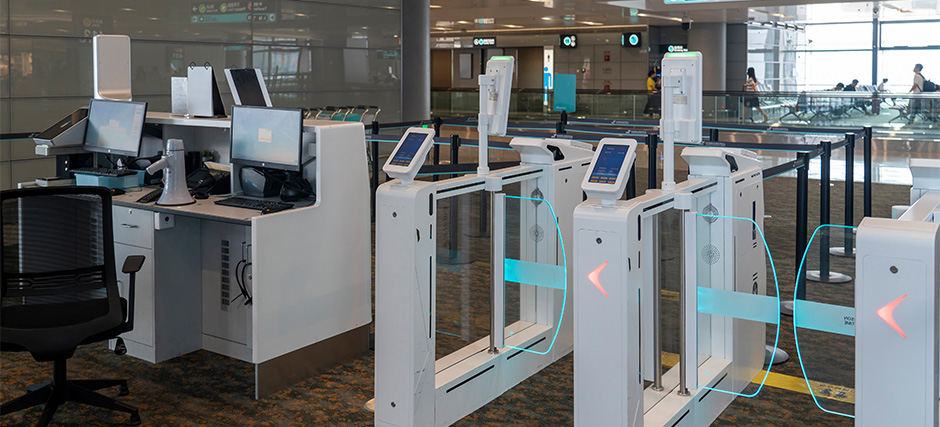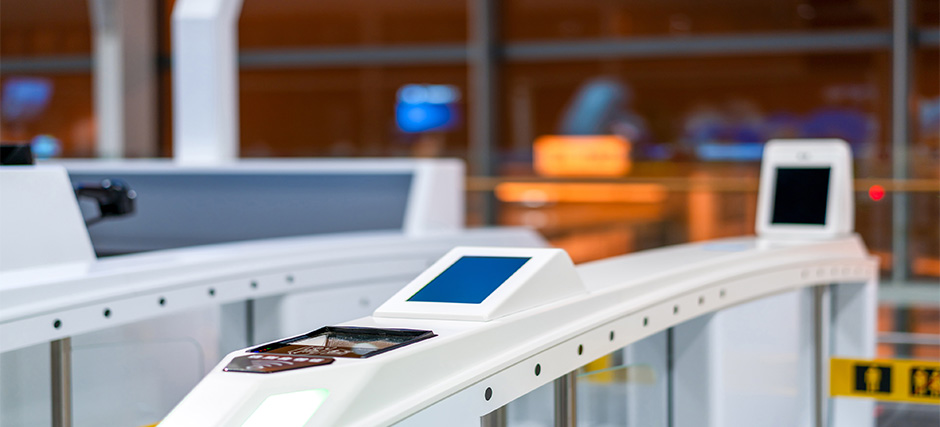The Future of the Immigration Security Solutions and System: Embracing Biometrics for Borderless Movement

The Future of the Immigration Security Solutions and System: Embracing Biometrics for Borderless Movement
Part 1: Introduction

Global mobility has entered a new era. As international travel resumes at full pace, the world’s immigration systems are undergoing a transformation shaped by digitalisation, automation, and trust. The conventional image of manual passport checks, inked stamps, and queues at immigration counters is rapidly fading. In its place rises a future powered by biometric systems, intelligent infrastructure, and secure digital identity management.
The next generation of border control does not just revolve around speed; it focuses on precision and experience. Today’s immigration systems combine advanced technologies such as facial recognition, iris scanning, and fingerprint authentication to create seamless passenger journeys that minimise human intervention whilst maximising efficiency and safety. For many nations, particularly those investing in border security technology, the goal is clear—to ensure that identity verification is both accurate and effortless.
In Singapore, for instance, biometric-enabled clearance points are becoming integral to airport terminals, reflecting a global shift towards automated immigration clearance. Travellers move fluidly through security checkpoints using facial and fingerprint scans linked to encrypted databases. The concept of smart borders, where identity is verified digitally and instantaneously, is quickly becoming an operational reality.
This evolution reflects more than convenience. The enhanced access control system central to this transformation represents a new frontier in how countries define security, sovereignty, and mobility. Behind every biometric door access system lies the same core principle that drives global immigration: the need to recognise individuals accurately, protect data integrity, and maintain national security.
As governments, airports, and technology providers innovate together, the immigration system becomes a living network—one that not only facilitates legitimate travel but also anticipates risks, streamlines flow, and builds trust at every step of the journey.
Key Takeaways
- Biometric systems are revolutionising the immigration system, replacing manual verification with digital precision and speed.
- The rise of smart borders and automated immigration clearance enhances both traveller experience and national security through seamless digital identification.
- Effective integration of border security technology and access control management systems is key to achieving safe, efficient, and future-ready travel ecosystems.
Part 2: Biometrics as a Gateway to Borderless Travel

2.1 From Stamps to Scans: How Biometrics Are Redefining Border Control
The evolution from paper-based passports to digital identity verification marks a pivotal transformation in modern immigration systems. Traditional entry processes once relied heavily on manual inspection, visible stamps, and human judgement. These methods, while familiar, were often limited by time and accuracy. Today, a new paradigm has emerged—one built on biometric systems, automation, and data-driven precision that redefine how travellers move across borders.
Airports and immigration authorities are now integrating facial recognition, iris scanning, and fingerprint authentication into daily operations. Each scan replaces what used to be minutes of document handling and questioning. The biometric door access system, for instance, captures and verifies unique personal identifiers against secure databases, minimising human error while increasing throughput. Collectively, these technologies enable smart borders that operate continuously, securely, and intelligently.
Modern eGates and automated immigration clearance lanes are key foundations of this advancement. Passengers are identified in real time using live image capture, which is then matched to passport or visa records. In some nations, travellers can even undergo biometric pre-clearance, allowing their identity to be verified before they arrive at their destination. Such innovations eliminate the need for repeated document checks and ensure truly seamless passenger journeys.
This transition is supported by robust access control management systems that integrate biometric data, analytics, and risk assessment into one unified platform. Authorities can detect anomalies instantly, manage passenger flow dynamically, and respond to threats more effectively.
The result is an immigration system that no longer views security and convenience as opposing priorities. Instead, it achieves both simultaneously, streamlining the traveller experience whilst maintaining the highest levels of verification integrity. This technological evolution represents more than just modernisation; it signifies a shift towards border control that is faster, smarter, and inherently more human-centred.
2.2 The Benefits of Biometric Immigration Systems
The modern immigration system built on biometric technology delivers measurable benefits for both travellers and authorities. These advantages extend beyond convenience, addressing the core challenges of identity verification, data accuracy, and operational efficiency.
1. Speed and Efficiency
Traditional passport control often involved manual checks that slowed queues and caused bottlenecks. With automated immigration clearance, travellers complete the process in seconds. By integrating biometric systems, airports can handle greater passenger volumes without expanding physical infrastructure.
2. Enhanced Accuracy and Security
Unlike physical documents that can be forged or misplaced, biometric identifiers, such as fingerprints and facial features, are unique to each person. This makes the immigration system more resilient against identity fraud. In parallel, border security technology powered by AI continuously monitors anomalies, ensuring every scan is verified against secure databases.
3. Personalised and Seamless Travel Experiences
The integration of access control systems with passenger data allows airports to create customised travel experiences. For example, once a traveller’s biometric data is verified, digital systems can automatically guide them through seamless passenger journeys involving priority boarding, luggage tracking, and personalised assistance.
4. Reduced Human Error
Automation minimises the risk of oversight at checkpoints. A biometric door access system operates consistently, applying the same verification criteria to every traveller, regardless of the volume of traffic.
5. Stronger Data Integrity
Through encrypted access control management systems, biometric data is secured at every point of capture, transmission, and storage. This ensures that privacy and compliance remain integral to the design of the new immigration system.
In essence, the shift towards biometrics enables a more connected and trusted travel environment. The traveller experiences ease; the authorities gain assurance. The underlying fingerprint door access systems, facial recognition algorithms, and integrated databases form the invisible backbone of tomorrow’s smart borders.
Part 3: Implementation in Practice—Global Case Studies and Challenges

3.1 Smart Borders in Action
The concept of smart borders is increasingly embraced and adopted globally. Nations have begun implementing large-scale biometric programmes that enhance both efficiency and control. Each case offers valuable insight into how the modern immigration system can function when powered by integrated technologies.
Singapore Changi Airport
Singapore’s Changi Airport is a prime example of innovation in this regard, implementing a comprehensive biometric immigration system that spans check-in, immigration clearance, and boarding. Using a unified access control management system, the airport integrates facial recognition and fingerprint data to create a continuous identity chain. This design exemplifies a fully realised seamless passenger journey, allowing travellers to move from entrance to gate without presenting a single document.
United Arab Emirates (UAE)
The UAE’s Smart Gates project is another example of biometric transformation. Using facial and iris recognition, the immigration system verifies travellers in under five seconds. The initiative integrates advanced border security technology, strengthening national safety while simplifying the visitor experience.
United States of America
The U.S. Customs and Border Protection agency employs the “CBP Facial Comparison” programme, a nationwide biometric system that compares traveller faces to passport and visa databases. It demonstrates how automated immigration clearance can serve both security and efficiency objectives simultaneously.
European Union (EU)
The EU’s upcoming Entry/Exit System (EES) exemplifies how regional collaboration can reshape an entire immigration system. By combining fingerprints and facial biometrics, it aims to manage border crossings for non-EU nationals efficiently. The project relies heavily on interoperable access control systems to maintain cohesion across multiple jurisdictions.
These examples show how the fusion of biometric door access systems and real-time data analytics can redefine border management. By uniting policy, technology, and operations, these initiatives illustrate the real-world potential of borderless travel.
3.2 Privacy, Data Sovereignty, and System Interoperability
The increasing use of biometric technologies brings significant responsibility. Every immigration system that collects and stores biometric data must ensure compliance, transparency, and public trust. Addressing concerns about privacy, sovereignty, and interoperability is crucial for the sustainable growth of smart borders.
Data Collection and Consent
Biometric verification depends on the accurate capture of personal data, which must be collected transparently and with informed consent. Robust frameworks are needed to ensure that every biometric system respects individual rights and adheres to local regulations.
Compliance with Privacy Laws
Governments deploying access control management systems must comply with international and local privacy laws such as the General Data Protection Regulation (GDPR) and Singapore’s Personal Data Protection Act (PDPA). Compliance not only safeguards travellers but also enhances the credibility of the immigration system.
Data Storage and Sovereignty
A growing challenge lies in determining where and how biometric data is stored. Some countries prefer domestic storage to maintain control, while others opt for secure cloud solutions. Whichever model is adopted, it must guarantee that the access control system remains tamper-resistant and accountable.
Cross-Border Interoperability
As travel becomes increasingly international, the ability for different nations’ immigration systems to communicate securely is essential. Standardised formats and encryption protocols allow one country’s biometric system to recognise and verify data from another’s. This interconnectivity supports faster processing while maintaining the integrity of border security technology.
Balancing Security and Freedom
Ultimately, every immigration system must strike a delicate balance between ensuring national security and enabling free movement. While biometric door access systems enhance verification, ethical governance ensures that these tools are not misused. Transparent oversight and responsible innovation are key to maintaining traveller confidence in the age of digital borders.
Frequently Asked Questions
1. Can travellers opt out of biometric screening at immigration checkpoints?
In most major airports today, biometric screening has become an essential part of automated immigration clearance, forming the foundation of a secure and efficient immigration system. The process helps authorities verify identities quickly and accurately, reducing reliance on manual checks. While some jurisdictions may still offer manual processing upon request, this option typically involves longer waiting times and additional document verification. In highly automated environments, opting out of biometric verification may not be possible due to national security regulations and the need for standardised screening at smart borders.
2. Is my biometric data shared with other countries or third-party entities?
Biometric data collected during border control is usually retained and managed by the country’s own immigration system, governed by its national privacy and data protection laws. However, limited data-sharing arrangements may exist between trusted partners or within international blocs such as the European Union, enabling cooperation on security and migration matters. These exchanges are carefully regulated and use encrypted channels within approved access control management systems. Transparency, retention periods, and consent requirements vary across regions, but all reputable border security technologies are designed to prevent unauthorised access and maintain data integrity.
3. What happens if the biometric system fails to recognise a traveller?
In the rare event that a biometric system fails to match a traveller’s data, perhaps due to worn fingerprints, poor lighting, or outdated database entries, the individual is directed to a staffed inspection counter. There, immigration officers will conduct manual verification using physical documents such as passports and visas. Additional identity checks may also be performed using secondary biometric sources like facial or iris scans. This redundancy ensures that even if a fingerprint scanner door access system or biometric door access system experiences a temporary mismatch, the immigration system continues to function smoothly and securely without compromising traveller safety or border integrity.
The future of global mobility depends on how successfully nations and industries can transform the immigration system into a secure, efficient, and traveller-centric experience. Biometrics form the cornerstone of this transformation, bridging the gap between safety and convenience through intelligent automation and trust-driven design.
The implementation of automated immigration clearance processes, supported by border security technology and interconnected access control management systems, has already begun reshaping how travellers move through airports and borders. From fingerprint door access systems that eliminate manual verification to advanced biometric systems capable of analysing live data, the evolution is visible at every checkpoint.
As governments pursue the ideal of smart borders, collaboration with private technology providers becomes essential. Here at iDLink Systems, we play a critical role in enabling this transition by supplying high-performance biometric door access systems and other integrated access control systems that empower organisations to adopt the same security standards driving next-generation immigration technologies.
The success of this global transformation relies on more than innovation alone. It demands a collective commitment to privacy, interoperability, and ethical governance. A truly future-ready immigration control system will not only verify identity but also build trust, ensuring that movement across borders remains as secure as it is seamless.
Looking to implement smarter, more secure access for your organisation? Shop now to explore iDLink Systems’ comprehensive range of biometric systems, built to shape tomorrow’s borders.
